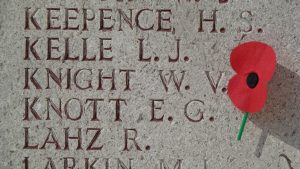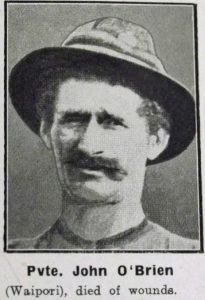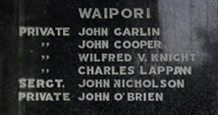
As the terrible conflict of the First World War gripped New Zealand, not even remote mining settlements such as Waipori escaped its impact. Many young men from the diggings enlisted in the army, and six did not return.
They are commemorated on the Lawrence war memorial and in far-flung parts of the globe. Here are their stories.
John Carlin (15134)
John Carlin was born in Nelson to Scottish immigrant parents, Daniel and Mathina (née Samson). The family ended up at living in an old store in Waipori, with Daniel working on a gold dredge and Mathina running a boarding house for a period.
John was only 11 when his hand was crushed on the Upper Waipori dredge; presumably he was working at that tender age. That injury, which resulted in the amputation of a thumb, saw him rejected when he first tried to enlist in the army in June 1915. But less than a year later the authorities were rather more desperate for replacements, and he left his job on the Golden Treasure dredge at Roxburgh and joined up.
By April 1916 his training had begun, and in July the troop ship Waitemata transported John to the UK as part of the 15th Reinforcements. After the usual training in Sling Camp in Wiltshire he was posted into the field in November of that year.
John doesn’t appear to have been comfortable with authority. In both July and September 1917, while serving on the Western Front, he was on several occasions absent without leave. This cost him a total of 17 days Field Punishment number 2, which involved him being kept in iron manacles and made to undergo hard labour and forced marches while carrying full kit. He also lost over six weeks’ pay. In November that year while on leave in London he was charged with drunkenness, and subjected to another seven days of that punishment and loss of four weeks’ pay.
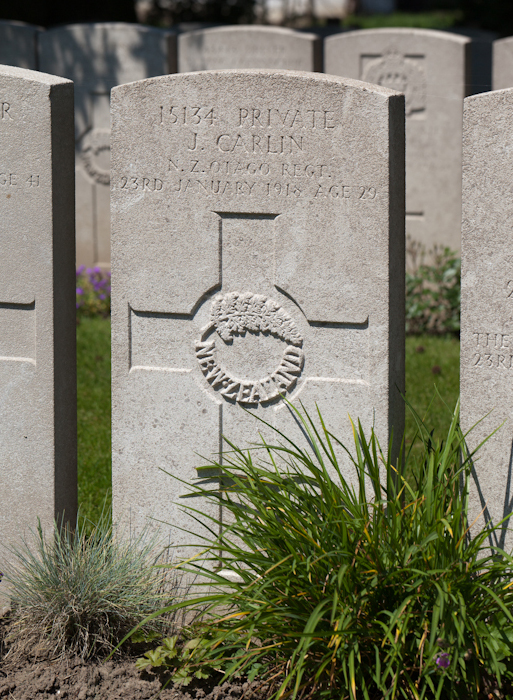
All this paled into insignificance, though, when he received a gunshot wound to the abdomen on 22 January 1918, and despite medical attention died the following day. He was buried at Lijssenthoek military cemetery near Poperinge in Belgium, location for many casualty clearing stations established near the Ypres battlefields. In 1921 his medals were issued and sent to his mother in Dunedin, though the plaque and scroll went to his father in Waipori.
John Cooper (8/1721)
John Cooper was a miner at Post Office Creek at Waipori when he enlisted in the army in January 1915 at the age of 36. In quick succession he made a will, joined the Otago Infantry Battalion and after just two months of training headed overseas. By early June he was in battle at Gallipoli in Turkey.
His service was brief, as on 27 September he was reported missing. He was one of many New Zealanders, out of more than 5,000 who died on the peninsula, who simply disappeared in the chaos of battle. A court of inquiry in January 1916 formally determined that he was believed to have died at Gallipoli on the day he went missing.
John was the son of James and Mary Ann Cooper, and brother of William, Ann Elizabeth and Ellen. In early 1915 William was a labourer in Dunedin, Ann was married to Ernest Davis and also living in Dunedin, and Ellen was married to William McCorkingdale and living in the Waikaka Valley. John’s major asset was his share of a mining claim owned together with James Robert Parker.
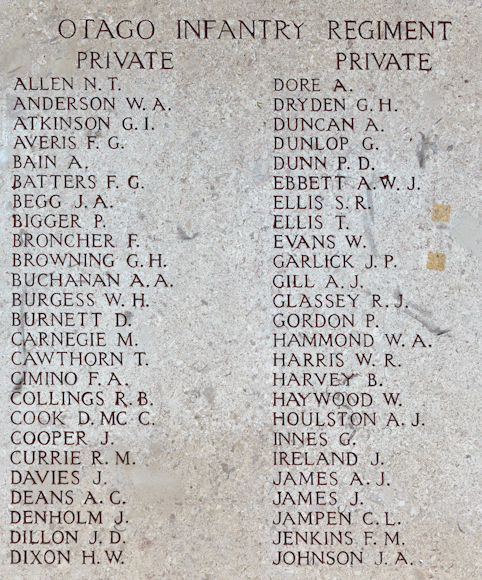
John Cooper’s next of kin was his mother Mary Ann, who was living with Ellen and William McCorkingdale, but by the time his medals were issued (1921) she had died and they went to his father, then living in Edinburgh Street in Waikouaiti.
John’s name is inscribed on a New Zealand memorial at Chunuk Bair, a high point on the Gallipoli peninsula that had been taken by New Zealand forces in August 1915 but held for only two days.
Wilfred Knight (710)
Wilfred Victor Knight’s war service is known to many who visit Waipori today, thanks to a memorial to him erected by his family just outside the cemetery. There’s an interesting story behind that memorial.
Wilf Knight was the son of Waipori identities Fred William Knight and Mary Snell Knight (née Lean). Fred had initially been a butcher in Waipori, but was later a successful gold miner in partnership with his brother William. Fred was at various times a justice of the peace, coroner, postmaster and registrar of births, deaths and marriages. He was also very involved in the Waipori Lodge.

Wilf Knight left the Waipori community in which his parent, uncles, aunts and grandparents were prominent citizens. Some say he didn’t get on well with his father. After a time on the West Coast he ended up in Sydney, where he worked as a tram driver. When war broke out he was living in Junee, a small town in New South Wales, and working as a locomotive fireman. He enlisted in the Australian forces less than three weeks after war began, with his regimental number of only 710 showing that he was among the first to sign up.
He was in the 1st Brigade of the 1st Battalion of the Australian Imperial Force, which arrived in the Mediterranean in early April 1915. He is thought to have been wounded in the first Australian landings on the Gallipoli peninsula, on 25 April 1915, and was evacuated to a transport ship, the Seang Choon. He died from his wounds on board some time between 27 and 29 April — record-keeping probably wasn’t the highest priority as the medical staff dealt with the rush of casualties — and buried at sea.
His father, Fred Knight, was keen to show that his son was the first casualty notified to the New Zealand Government from Australia. He enlisted the help of a Dunedin member of parliament, Thomas Sidey, who in 1916 sought information from the Australia authorities on the matter. Knight Senior was eager to establish this fact, perhaps to help him take something special from the tragic loss of his son. Eventually it was confirmed that Wilf’s death at Gallipoli was the first of a New Zealander that was notified by the Australian authorities to New Zealand.
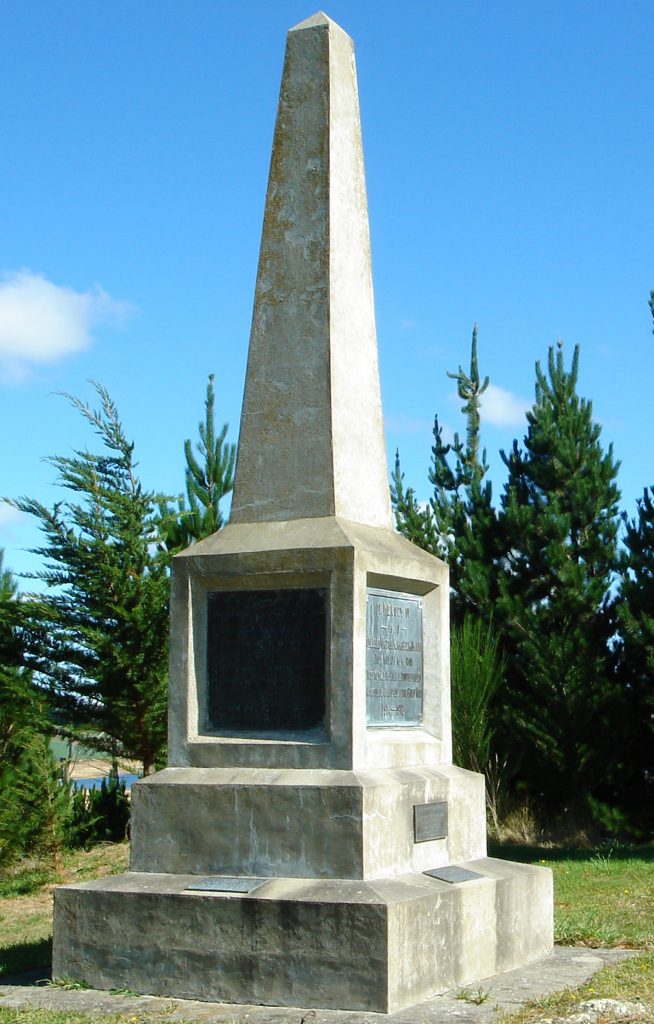
In 1935 Wilf’s brother Eric (who was wounded at Gallipoli) built the memorial at Waipori, which was paid for by their father Fred. By this time this point of difference attached to Wilf’s death had morphed into the “first New Zealander reported killed in action on Gallipoli”. This wasn’t correct, as the New Zealand newspapers contained casualty lists from Gallipoli at the same time as Fred Knight received his information from Australian authorities via the New Zealand military.
Wilf’s Victory Medal, Memorial Scroll and Memorial Plaque weren’t despatched to Fred Knight until 1921 and 1922. Wilfred Victor Knight is commemorated on the Australian memorial at Lone Pine, on Gallipoli peninsula. In 2010 a Waipori descendant visited and left a poppy by his name.
Charles Lappan (8/2036)
Charles Lappan mined in the Post Office Creek area, working with James Robert Parker and John Cooper who are mentioned above. And, like John Cooper, he was to lose his life at Gallipoli.
Charles was born in Invercargill to Irish/English immigrant parents Michael and Frances Lappan, who later settled in Dunedin. Charles was mining at Waipori, aged 32, when he joined up in January 1915, the same month as his partner John Cooper.
In early June 1915 he went into action at Gallipoli, and just two months later he was reported wounded. Extensive enquiries as far afield as England, Egypt and Malta found no trace of him in the confusion of war (thousands of wounded were evacuated from the peninsula, and ended up in military hospitals across the Mediterranean and in the UK).
In May 1916, after a no-doubt agonising wait for his family and friends, it was officially declared that he was believed to have died of wounds at Gallipoli on or about 7 August 1915. Like his mate John Cooper, his body was never found and he is commemorated on the Chunuk Bair memorial.
John Nicholson (16784)
John Nicholson was the son of a miner of the same name and Sarah Nicholson (formerly Russell). After attending Waipori school he worked as a miner at Waipori and as a storeman there and in Luggate. In 1915 he married Dorothy Kent in Oamaru and the couple settled there, and were joined by a daughter Audrey the following year.
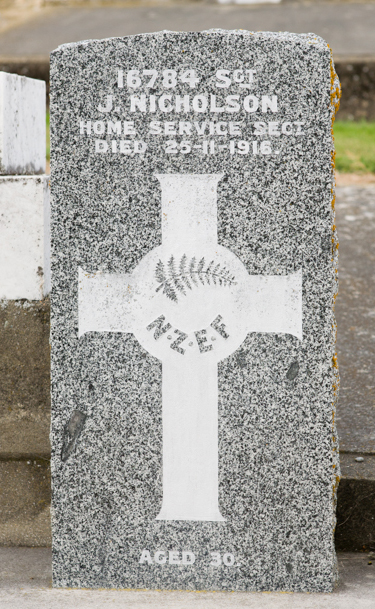
When John joined up in March 1916 he was working as a traveller in Oamaru. He was soon promoted to Sergeant, and was working in the records office at Featherston military camp when he became ill. He died on 26 November 1916 from tubercular bronchial pneumonia after just a week in hospital. He was buried with full military honours in Oamaru old cemetery, and is commemorated on the Featherston war memorial.

John O’Brien (48419)
John was the son of Irish immigrants Daniel and Bridget (née Mulcahy) O’Brien, and part of a large family with extensive mining interests in Waipori. He had been mining in partnership with his brothers Thomas and Kennedy for about 18 years when John and Kennedy were called up in January 1917. Their appeal against conscription was unsuccessful, so they donned army uniforms.
In March 1917 John was posted to training at Featherston camp. He got off with light punishment when found drunk in Featherston late one night in May. John left New Zealand on the Willochra in June 1917, and after training at Sling Camp in Wiltshire he left for France in late October 1917. He was in action on 11 November 1917.
After just over two months in the field, John was shot on 23 January 1918. Despite medical attention he died the same day, and was buried on 24 January at Menin Road South Cemetery.


